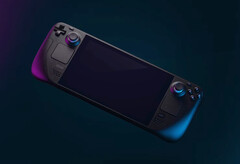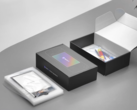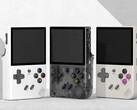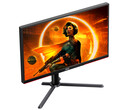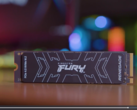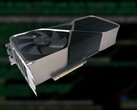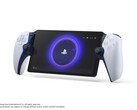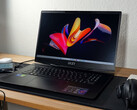Valve has now released the Steam Deck OLED, the mid-generation refresh of its popular gaming handheld. To recap, the company announced the Steam Deck OLED out of the blue, not only with a new display but also a revised SoC, among other improvements. Please see our Steam Deck OLED launch article for full changes from Valve's original model.
For reference, the Steam Deck OLED starts at US$549 with a 512 GB SSD but is also available with a 1 TB SSD and in 1 TB Limited Edition form for US$649 and US$679, respectively. Incidentally, Valve has pushed four SteamOS stable updates in as many days, culminating in SteamOS 3.5.5 for all Steam Deck units. Typically, the company shares updates on the SteamOS Preview Channel first, which you can opt into by heading to Settings > System > System Update Channel and select Preview Channel.
As far as we can tell, SteamOS 3.5.5 bundles all the changes found in SteamOS 3.5.2 through 3.5.4, including Steam Deck OLED support. However, Valve's latest SteamOS build also includes various other bug fixes and improvements, such as switching to the sRGB colour space for the Steam Deck LCD to create a warmer colour tint and a more vibrant overall look. Incidentally, SteamOS 3.5.5 arrives alongside a new Steam Deck Client update, which contains a separate round of refinements for all Steam Deck models. The changes that both updates bring are as follows:
Display
- The default colour rendering for Steam Deck LCD has been adjusted to emulate the sRGB colour gamut, resulting in a slightly warmer and more vibrant colour appearance.
- Added Settings -> Adjust Display Colours, to tune the display's Color Vibrancy and Color Temperature. The settings can be tuned with a preview of a test image (above), or with your running game.
- Native: The native display colour appearance (the colour rendering for Steam Deck prior to this update).
- sRGB: Emulate the sRGB primaries in a smooth manner that does not introduce gradient clipping.
- Boosted: Emulate a wider-gamut display appearance, resulting in increased apparent vibrance. May result in gradient clipping.
- HDR can now be enabled in Display Settings if supported by the external display.
- Added HDR Analysis to Advanced Display settings.
- VRR can now be enabled in Display Settings if supported by the USB-C adapter.
- Reworked Quick-Access scaling settings to separate scaling from filtering. Added Stretch and Zoom scaling as new options to handle different aspect ratios.
- Fixed a long-standing issue where the internal display backlight would always stay on.
- Fixed touchscreen orientation while an external display is connected.
- Compositing is now avoided in additional scenarios, reducing latency and stutter in situations with multiple overlays on screen.
- Improved latency in certain situations where the application renders slower than the display's refresh rate.
General
- Added support for Steam Deck OLED.
- Fixed an issue where certain workloads would exhibit severe CPU performance issues unless SMT was manually disabled.
- External storage devices are now auto-mounted when connected to Steam Deck. To format or manage storage devices, use the new device management interface in Settings->Storage.
- Updated graphics drivers, with many performance and functionality improvements. Improved performance for Starfield. Fixed viewmodel corruption in Amnesia: The Bunker and launch failures for Immortals of Aveum and Kaiju-A-GoGo.
- Improved Bluetooth connection stability, especially with multiple controllers.
- Slightly improved sleep resume speed.
- Implemented switching between controller bindings and mouse/keyboard desktop bindings by long-pressing Options in the Linux hid-steam driver, to match Steam's default Desktop configuration.
- Improved fade transitions between applications.
- The contents of the performance overlay can now be customized by creating a ~/.config/MangoHud/presets.conf configuration file.
- Fixed a bug where some games could appear stretched if their window size didn't match their swapchain size (e.g. Naruto Shippuden Ultimate Ninja Storm 4).
- Fixed Disgaea PC needing to be tapped on before input works.
- Fixed physical dimensions reported to games, fixing some issues with an incorrect aspect ratio sometimes being detected (eg. Returnal).
- Worked around a problem where Allow Tearing could cause heavy stuttering if the Performance Overlay or other overlays appeared on screen. Tearing is now impossible in such situations, and the Performance Overlay should be disabled for best results.
- Fixed a problem where keyboard input would not be detected in Overwatch 2.
- Controller firmware: fixed an issue where some thumbstick touch sensors would lose touch periodically.
Firmware 118
- Added voltage offset settings.
Steam Deck Dock Firmware 121
- Added VRR support.
- Improves reliability when changing display modes via on-screen menus.
- Fixed issues with 6bpc colour modes, improving high resolution/refresh mode support.
- Improves detection of HDMI cable hot-plug events.
Updated Arch Linux base
- This update pulls in newer performance, security and stability fixes for the underlying packages that are the foundation for SteamOS.
- New window tiling system.
- Updated Discover (app store/software manager) with a new homepage and improved search.
- Discover can now perform system updates from the desktop.
- Updated desktop widgets.
▶ Steam Deck Client Update: November 16
- This update has been re-released with the following fix
- Fixed video freeze when streaming games with launchers when using NVIDIA hardware encoding
General
- Allow local game content transfers from a plugged-in Steam Deck to other Steam clients on the same LAN.
- Fixed setting the correct AppID in Source SDK mod manager.
- Visual tweaks to Steam Deck, Big Picture Mode and SteamVR: Many small changes throughout to make the user interface a more visually-rich experience in Home, Library and other areas.
- Nicer layout for Soundtracks pages. These pages are now easier to navigate in Big Picture Mode and feature larger artwork on Desktop.
- Fixed some layout and interaction bugs in the Media viewer.
- Move the controller support information in the desktop client from the play bar to a widget in the right column
- Add HDR badge to app details for games that are marked as having HDR output.
- Fix bug preventing you from launching a game that had temporarily disabled auto-updates if new workshop content was available
- Additional information about controller support has been added to the client:
- Game details pages in the library will now show information about specific controller and VR support in the right-hand column when devices are connected
- PlayStation controllers have a new default mode in Steam Input where Steam will route controllers to the game's built-in support if available and to Steam Input when they would be unsupported. These controllers can still be globally opted-in or out of Steam Input in the controller tab of the Steam settings page.
- The landing page of the controller configurator now has controller support information, and it has been made easier to quickly opt in or out of Steam Input for a particular game.
- In the Big Picture library there is now Xbox/DualShock/DualSense support tabs similar to the "Great on Deck" tab that are populated based on your connected devices.
- DualShock, DualSense, and Steam Input API support have been added to the available filters in the library.
- Games that require controllers (no mouse/keyboard support), require a VR Headset, or support both VR and standard game modes will now show that information in the client, similar to how it displayed in the store.
- Footer icons for DualSense controllers in Big Picture have been updated to use the black and white style on the device.
Remote Play
- Fixed hidden mouse cursor when streaming to Android TV.
- Fixed stream lockup when using Intel iGPU hardware encoding.
Steam Input
- Improve look of the configurator when there are no controllers connected
- In games that support SteamInput API Actions we no longer hide the Flick Stick as Mouse option if a FlickStick action is defined - this is so that Gyro To Mouse can be properly complemented if you wish.
- Fixed the ROG Pugio II mouse showing up as a controller
- Fix: Gyro Joystick mode: Core gyro quaternion is updated even when the app requesting it is not focused.
- Fixes to both Gyro as Joystick Modes: Min/Max remapping was not allowing values to become zero when gyro values were less than the minimum required joystick output values.
- Gyro to Joystick (Deflection) mode uses a sensor fusion controller accelerometer rather than quaternion for more consistent behaviour. This should address issues where the X output would become canted in the legacy modes. Note: it may feel subtly different. Feedback welcome.
Source(s)
Steam (1) (2) (3) (4) (5) via Steam Deck HQ (1) (2) (3), Alexander Andrews (Unsplash) - Image credit




